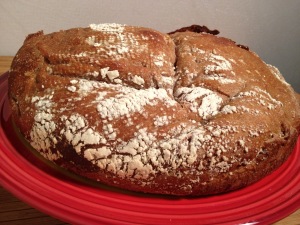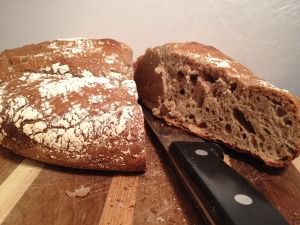Vegan day 113: PAIN AU LEVAIN aka sourdough bread
PAIN AU LEVAIN: aka sourdough bread!
I think that’s what I made. I am not a bread maker by any means nor a fermenter (yet) so I’m not 100% up on the terminology, hence the procrastination of writing this blog. Interestingly enough, I have never been more proud of my “cooking” self as I was tonight! I have never made bread- not even anything close unless you would like to include the multi colored Easy Bake Oven mini cakes I made when I was a kid!
I called this fermented bread. I learned this in the class I attended at the Natural Gourmet Institute for Food & Health, NYC: The Miracle of Lacto-Fermentation by Peter Berley. When I posted my bread making status on Facebook, I received a few texts for sure from friends asking… WHAT IS FERMENTED BREAD? I will say– it’s probably sourdough bread if that is a more familiar term. Through my studies I have heard about sourdough bread many times for it’s alkaline and pro-biotic ingredients. I never came across it though in my daily vegan travels. I love bread– honestly, who doesn’t. It’s one of my big three AVOIDANCES though. That’s my beginning commitment to take control of my health. That’s how it all began. That’s how I kickstarted my internal health movement for my body. No white bread- No white pasta- No white rice! Simple!
So what is sourdough bread anyway? Why is it not only good.. but super beneficial?
I found many sites and recipes online for sourdough bread. I will highlight the first paragraph from wikipedia for this one:
“Sourdough is a dough containing a Lactobacillus culture, usually in symbiotic combination with yeasts. It is one of two principal means of biological leavening in bread baking, along with the use of cultivated forms of yeast (Saccharomyces). It is of particular importance in baking rye-based breads, where yeast does not produce comparable results. In comparison with yeast-based breads, it produces a distinctively tangy or sour taste, mainly because of the lactic acid produced by the lactobacilli; the actual medium, known as “starter” or levain, is in essence an ancestral form of pre-ferment.” ~Wikipedia
Here is another good site for reference: http://www.angelfire.com/ab/bethsbread/WhatisSourdough.html
SOURDOUGH BREAD is beneficial:
- More easily digestible since the proteins/ glutens are broken down into amino acids which may make it possible for gluten sensitive people to enjoy
- Has a lower glycemic index; lowers insulin response and increases blood sugar stability
- Activates phytase to dissolve phytates and physic acid; this frees up minerals in the body
- Lactic acid helps predigest the grain and creates the sightly sour taste
Peter gave us some starter culture in class. I had to feed this– and I still do because I want to make this bread again and again. I feed it by removing some and then adding whole wheat flour and water.
There are many YouTube videos online about making sourdough bread. I’ll briefly summarize what I did but you would need to make or obtain a starter to make it this way.
I had to review this recipe several times and set aside 24 hours for waiting, fermenting, kneading and stretching the dough– well worth it!
- I took only 1/4 cup of this special starter culture from class and mixed it with 1/2 cup water and 2/3 cup whole wheat flour- this I let sit out overnight (8) hours at room temperature.
- The next morning, I took the mixture into a large mixing bowl and added 1 3/4 water and 2 teaspoons of sea salt
- Next I mixed in 2 1/2 cups of whole wheat flour and 1 cup of unbleached white flour. I placed this dough on a lightly floured surface and inverted the bowl over the dough to hydrate– 30 minutes.
- I uncovered the dough and kneaded it for 7-8 minutes.
- Slightly oiled the mixing bowl- added the dough- covered it with plastic wrap and let ferment 20 minutes.
- I stretched and folded the dough and left again for 20 more minutes (did this two more times).
- Now I let the dough stay for 4 hours to double in size.
- Next I turned the dough onto the counter top to gently deflate
- I shaped it into a boule and let it rest 5 minutes seam side down
- I lightly floured a cloth and set it in the bowl.
- I inverted the dough back into the mixing bowl and covered with saran wrap for 2 more hours.
- 40 minutes before baking I took my new 4-5 quart Dutch oven into the oven and preheated it to 470 degrees
- Remove the dutch oven carefully- invert the dough into the pot, slash it and bake for 50 minutes– check for an internal temperature of 210 degrees.
- Cool for an hour and slice.
References:
http://en.wikipedia.org/wiki/Sourdough
http://www.kitchenstewardship.com/2010/03/05/food-for-thought-health-benefits-of-sourdough/
http://www.simplebites.net/the-health-benefits-of-sourdough-bread-recipe-whole-grain-sourdough-bread/
http://www.wildyeastblog.com/2010/05/06/sourdough-for-health/
My experiences are up-to-date but sometimes the writing lags a day or so. My apologies! Disclaimer: The information given here is for educational purposes only. You should not use this to diagnose or treat a health problem or disease without consulting with a qualified health care provider.
[Sunday April 22nd 2012 blog]



